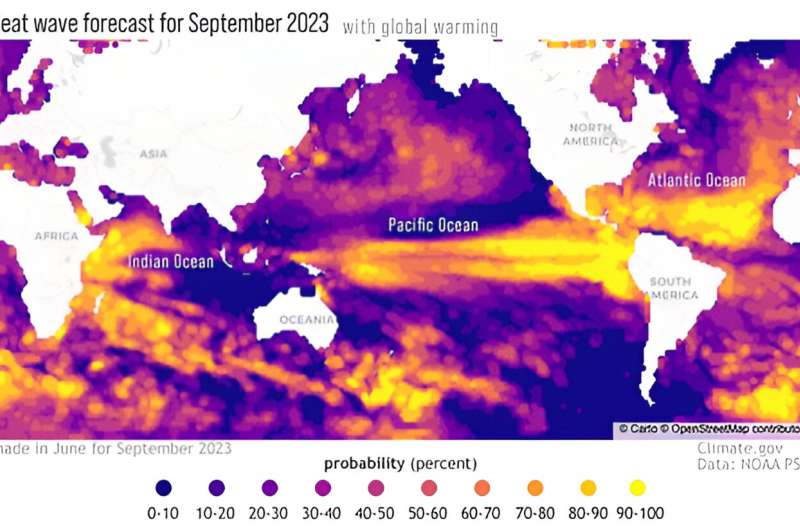This article has been reviewed according to Science X's editorial process and policies. Editors have highlighted the following attributes while ensuring the content's credibility:
fact-checked
trusted source
proofread
More marine heat waves could spell disaster for ocean life

Marine heat waves are becoming more frequent under global warming and this is having a significant impact on species' ability to recover.
Since April, the world has seen record high ocean temperatures and that's bad news for the plants and animals that call the ocean home.
Longer and more frequent bouts of extreme temperatures can cause the exodus of some species and the invasion of others, with potentially devastating impacts on the resident ecosystem.
Global warming manifests as a gradual increase in temperatures over time around the world, caused by increased greenhouse gas emissions.
However, scientists are finding that the most important impacts come from short-term spikes in temperature.
In the ocean, these discrete periods of extreme temperatures, lasting weeks to months, are called marine heat waves.
Marine heat waves can be generated by either the atmosphere or by ocean processes.
For example, weather systems like high pressure systems can lead to low cloud and greater solar heating while ocean changes can be driven by strengthened poleward currents that move heat from high to low latitudes.
The likelihood and intensity of these atmospheric and oceanic drivers of marine heat waves can also be affected by large-scale phenomena like El Niño or La Niña.
Larger portions of the oceans are likely to experience marine heat waves during El Niño events.
Marine heat waves can have dramatic impacts on marine organisms and ecosystems that may extend for long periods after temperatures have returned to normal.
Mass deaths
Impacts range from the suppressed growth of microscopic marine plants to mass deaths in fish and marine mammals, encroachment of invasive species and toxic algal outbreaks.
Importantly, marine heat waves have been associated with extensive dieback of species like coral reefs, kelp forests and seagrass beds that form the homes and breeding grounds for a large amount of the ocean's biodiversity.
These impacts can have devastating knock-on effects for fisheries, aquaculture and tourism industries, with individual events linked to direct losses of up to hundreds of millions of dollars.
The Ningaloo Niño that formed early in 2011 was an iconic extreme event.
Intensified winds along the Pacific equator—associated with an extreme La Niña—forced warm water westwards and through the Indonesian Archipelago, into the Indian Ocean and poleward along the coast of Western Australia.
This flood of warm water caused a record-breaking marine heat wave that wiped out the endemic kelp forest for over 100 km along the Australian coast along with one-third (1,300 square kilometers) of the Shark Bay seagrass meadow, a UNESCO world heritage site.
The Ningaloo Niño caused deaths and reduced reproduction in abalone, scallops and crabs that led to the closure of associated fisheries for several years.
Trouble in the Tasman
The Tasman Sea is another hotspot for ocean warming and marine heat waves.
Two consecutive extreme events occurred the summer of 2015/16 and 2017/18. Their causes were very different.
The first was primarily caused by an intensification of the warm East Australian Current while the second was caused by a long-lasting high pressure system over the ocean.
These and previous events brought an invasion of sea urchins from mainland waters that led to the decimation of kelp forests off eastern Tasmania.
The 2015/16 event alone led to new diseases in cultured oysters, poor salmon performance and high mortalities of abalone. Together this led to economic losses of more than half a billion dollars.
As marine heat waves exist on the backdrop of long-term global ocean warming, these extreme events are becoming more intense and more frequent.
Over the past century the number of days each year experiencing marine heat wave conditions has increased by more than 50 percent.
The shorter time between marine heat waves means that many populations no longer have the time to recover between events, which can lead to species moving their range or being wiped out.
And this will only worsen in the future.
Many studies show that some coral reefs are losing their hard corals.
And with increased future warming the very existence of tropical coral reefs are in doubt.
Since April, the oceans have been warmer than at any time during the instrumental record.
Warmest in 100,000 years
It's probably at least 100,000 years—before the last ice age—since temperatures could have been this warm.
As a consequence, scientists are seeing more of the ocean experiencing marine heat wave conditions than ever. And that's before the added push from the developing El Niño.
Over the past few weeks alone, there have been extreme marine heat waves in all of the ocean basins, including around the UK and Japan, off Peru and in waters extending off of the Californian, Florida and east and west Canadian coasts.
As the Northern Hemisphere enters its warmest season, marine heat waves are at their most dangerous, pushing marine organisms above their thermal limits.
Over the next few months, expect reports of significant ecosystem harm to start to emerge.
An understanding of the physical drivers of these events and their biological impacts provides scientists with some ability to forecast their likelihood in the future.
This can help marine resource managers make decisions, like moving aquaculture stocks, reducing fishing quotas or taking direct action to suppress warming (like shading of aquaculture cultivation areas, or moving aquaculture pens out of harm's way) in small, high-value regions.
But ultimately, to avoid escalating impacts the only solution is to stop greenhouse gas emissions.
Provided by University of New South Wales
Originally published under Creative Commons by 360info.




















